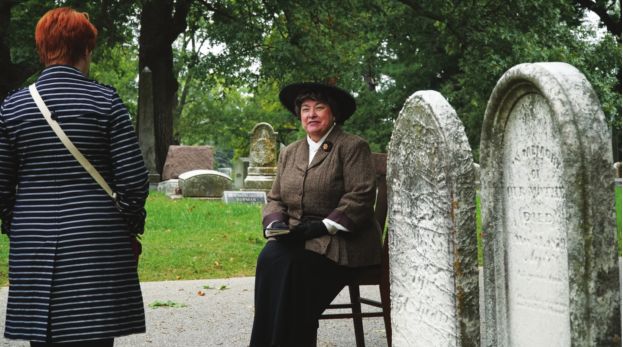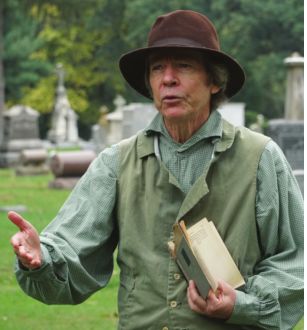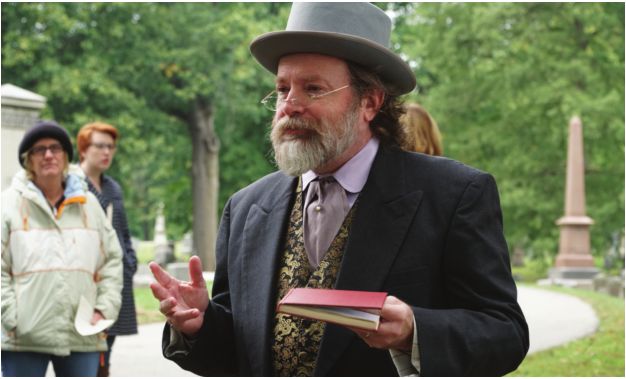
A walk through Oak Ridge Cemetery
In the late 19 th and early
20th centuries, cemeteries were the first public parks. Women strolling
with parasols and families spread out on blankets enjoying a picnic
would be a common site. The living paid respect to their loved ones and
celebrated their own lives. Oak Ridge Cemetery, no doubt, would have
been a popular place here in Springfield.
The
rolling hills and majestic trees of Oak Ridge Cemetery will be the site
of the Sangamon County Historical Society’s “Echoes of Yesteryear: A
Walk through Oak Ridge Cemetery,” which will remember and pay respect to
seven people from Springfield. Mary Alice Davis, the chair of the event
to be held Oct. 6, says, “The walk will provide a glimpse into the
history and heritage of Springfield and Sangamon County.”
Actors
and actresses in period costume will narrate accounts of people who
have a connection to Springfield schools. The names are familiar: Bunn,
Butler, Dubois, Matheny, Ridgely and Iles. Actors will portray the
person or someone connected with the family. In addition, one of the
first women to serve on the Springfield school board, Mary Morrison,
will be portrayed.
About the cemetery walk
Sunday, Oct. 6
12 noon-4 p.m.
(last tour is at 3:15 p.m.) Free. Donations accepted
Books published by the Sangamon County Historical Society will be available for purchase.
Parking
available below the hill of Lincoln’s Tomb. Shuttles will transport
people in groups to the first gravesite. Participants will then walk to
the other graves (around ½ mile). Allow two hours.
Refreshments will be available for purchase at the African American History Museum at the entrance to the cemetery.
Jacob Bunn (1814-1897),
a close friend of Abraham Lincoln, founded the Illinois Watch Company,
owned Bunn Capitol Grocery and started Marine Bank at the corner of
Sixth and Washington. Bunn, known as a hard worker, died at his office.
At his death at age 83 the Illinois State Journal wrote, “Despite
his advanced age, Mr. Bunn was remarkably active to the very last and
could perform more work than most men many years younger. No man played a
more prominent or more important part in the upbuilding of the city of
Springfield than Jacob Bunn.”
Bunn
School was built in 1905 by the Springfield architectural firm Helmle
and Helmle, known for designing many schools, businesses and homes that
are still standing in Springfield. Bunn School, though, which was at 12
th and Division streets, was demolished in 1974.
Bunn
will be portrayed by Andy VanDeVoort, a retired music and band teacher,
who has acted in various productions. This will be his first cemetery
walk. He taught in the Springfield school district and serves as bugler
for the 114th Illinois Infantry, which performs the Flag Retreat at the
Lincoln Tomb throughout the summer.
William Butler (1797-1876)
was born in Kentucky. At the age of 15, he carried messages from the
Kentucky governor to the commanding officer during the War of 1812. He
served as a clerk on a steamboat before coming to Springfield in 1828.
Here, he served as circuit clerk; he was the one who entered Abraham
Lincoln’s admittance to the bar on the court record after Lincoln passed
his law exam in 1836. Butler often invited Lincoln to his home for
dinner. Butler also served as state treasurer, appointed by Gov. William
Bissell in 1859, and was elected two additional times. Camp Butler
cemetery is named after him.
Butler School, on the corner of MacArthur and Laurel streets, was built in 1921, also designed by Helmle and Helmle.
Butler
will be portrayed by Pat Foster, an attorney for the state of Illinois
for 40 years, who has acted in various productions and in previous
cemetery walks. “I do my best to learn the script we’re furnished,” he
says. “They’re always well-crafted and furnish the substance of the
character. I also try to research the character’s era.”
Jesse Dubois (1811-1876)
had been a neighbor of the Lincolns. He later was one of 15 directors
of the National Lincoln Monument Association. At the age of 24 he served
in the House of Representatives, and in 1856 was elected auditor of the
state. Dubois and Butler knew each other and were listed in an 1863
newspaper report as honorary managers for the fifth annual festival
commemorating Benjamin Franklin, held at the St. Nicholas Hotel.
Dubois
School at 120 S. Lincoln has an interesting history. In 1867 Dubois,
who lived at the current site of Sacred Heart Convent, bought land at
the southeast corner of what is now Washington and Lincoln streets. The
area was the original site of the Illinois State Fair in 1853 and then
Camp Yates, a Civil War camp where Ulysses S. Grant reenlisted. A school
was built, which burned down in 1891, then was rebuilt and called West
Springfield School. In 1896 the city annexed the area and the
Springfield school board took over the building, renaming it Dubois. By
1915, it and other schools had been condemned. Plans to build a new
school in 1916 were delayed due to several factors – lack of funds,
other schools being remodeled and the construction of a new high school.
One wing opened in 1916. In 1917 the full construction was completed.
Dubois
will be portrayed by Dennis Rendleman, his third year to participate in
the cemetery walk. The connection of the site of Dubois School to Grant
is fitting as Rendleman will be portraying Grant in a play opening in
December. He says, “I don’t like to just memorize a script but talk from
what I remember and sometimes use a book that has notes as a prompt.
Last year that worked perfectly since I was portraying an attorney and
had found a book that talked about the character.” Rendleman is the
ethics counsel at the American Bar Association and commutes between
Chicago and Springfield.
Maria Matheny (1828-1909)
was the wife of James Matheny (1818-1890). Her father had been a
circuit clerk who died when Maria was an infant. When her mother
remarried to Colonel Edward Baker, they moved to Springfield. Maria was 3
years old. Baker was killed during the Civil War. In 1845 Maria married
James, and they had seven children; four sons survived her. She was
active in the First Methodist Church. She died of bronchitis at the age
of 81.
James Matheny
was a Sangamon County judge, circuit clerk and a lieutenant colonel in
the Civil War. He was known to be a great orator. He served as Abraham
Lincoln’s best man at his wedding in 1842. Matheny’s funeral is believed
to have been the largest Springfield has ever seen except for
Lincoln’s.
Matheny
School was originally called Brainerd and stood at Capitol and Wheeler.
It was rebuilt in 1909 by Helmle and Helmle and renamed Matheny. That
building was located at 2200 E. Jackson St. At the end of the 2004- 2005
school year, it was closed. At the start of the 2005-2006 school year,
Withrow School at 1200 S. Pope became the Matheny-Withrow Elementary
School.
Maria Matheny
will be portrayed by Tracy Petro. This will be her fifth cemetery walk
portrayal. Petro says, “I will be telling about Judge Matheny but also
focus on Maria and her role in her husband’s success.” Petro is a clinical research coordinator for Clinical Radiologists.
Rebecca Woods (1810
or 1812-1865), an African-American servant of the Ridgely family, is
buried in the Ridgely family plot. Nicholas Ridgely (1800-1888) operated
the Ridgely Bank that stood at Fifth and Monroe. Woods was born in
Maryland, Ridgely’s home state. A slave of Greenbury Ridgely, she was
given to Greenbury’s son, Nicholas, as a wedding gift. She helped raise
his 13 children from his two marriages but never herself married or had
children. Woods was buried in Hutchinson Cemetery (now the site of
Springfield High School) along with Ridgely family members. In 1874
bodies from the cemetery were moved to Oak Ridge. The current Ridgely
School was built in 2005.
The
first Ridgely School stood at 1013 Fair Grounds, now known as Sangamon
Avenue, and in 1900 a new school was built on the present Eighth Street
site.
Woods will be
portrayed by Veronica “Roni” Betts who has been portraying characters at
historic sites since 2010, including previous cemetery walks. She says,
“I plan to talk about Rebecca but also about Ridgely who was a
wonderful father and actually gave Rebecca a good life.” Betts will be
wearing a dress of royal blue trimmed in black silk with a hat that
matches. Betts says, “Sunday was Rebecca’s day off and she knew people
and hobnobbed with many. My hat represents that she was a respectable
church lady of her time.”
Rebecca Woods was remembered in the Illinois State Journal obituary: “Her familiar
face was known to all our citizens and her genuine goodness of heart
made her a general favorite. Her Sunday afternoon visits among the
neighbors were regularly made for many years, and her coming was always
hailed with pleasure by old and young alike.”
Malinda Benjamin Iles (1804-1866)
was the wife of Elijah Iles (1796-1883), Springfield’s first
storekeeper. Malinda was born in New York. Around 1818 she traveled on a
flatboat on the Ohio River with her uncle and a couple named the Shaws
to St. Louis. The uncle returned to New York to bring Malinda’s mother
back but instead married her and stayed in New York. Malinda became a
teacher of predominately French-speaking students in Cape Girardeau. The
Shaws later moved close to Springfield; while Malinda was visiting
them, she met Elijah. They married in 1824 and had two children. At the
age of 88, Elijah Iles wrote Sketches of Early Life. About his
wife he said, “She was my superior in intellect and I never realized her
worth until she was gone, gone, gone from me forever.”
Iles
School is at 1700 S. 15 th St. The land was donated in 1870 and a
two-room school was erected. Additions and remodeling occurred over the
next 50 years. In 1920 another remodeling project started and in 1922 a
new addition opened, designed by architect Murray Hanes. (His mother was
on the school board. See Mary Morrison.)
Malinda
Iles will be portrayed by Mary Disseler. She says, “I was sent three
possible people to enact and chose Malinda because I wanted to learn
more about the beginnings of Springfield. I’ll speak as a very proud
wife and speak to inform others of our colorful and enterprising
founding fathers.” She will be dressed in a yellow calico dress from the
Civil War era. Disseler is retired from state government and has
devoted her time to serving as a living history interpreter. She
volunteers at the Abraham Lincoln Presidential Museum and acts in
various performances.
Mary Morrison (1880-1939)
- The first opportunity most women had to cast ballots in local school
elections throughout Illinois was in April 1892. Almost 20 years later,
in 1911, two women – Mary Morrison and Ida Hanes – were elected to the
Springfield school board. Morrison supported efforts of Superintendent
Hugh Magill including building Springfield High School; Hanes opposed
the superintendent. Morrison was characterized as a progressive, Hanes
as a reactionary, according to newspaper accounts. Their disagreement
came to a head in 1921 when Morrison voted against hiring an architect,
Murray Hanes, Ida’s son. Both women served on the school board for many
years, Hanes for 11 years and Morrison for 12 years. Each took a turn
serving as board president.
In 1913, two years after Morrison and Hanes were elected to the school board, Governor Edward Dunne signed into law the right of Illinois women
to vote in U.S. presidential elections, many years before that became a
right of all women across the country.
Mary
Morrison will be portrayed by Linda Schneider, office administrator for
the UIS Office of the Provost. She has acted in all the cemetery walks
except the first one. Schneider laughs, “I guess I do a lot of dead
people talking.” She began acting in the 1970s and has had various roles
in many local productions. She says, “Many times, when portraying a
woman from our early history, the only information available is about
her husband and children and so we must plan our presentations with that
focus. By portraying Mary, I get to talk about her and her unique role
in the community.”
Planning
a cemetery walk Planning for this event takes considerable work and
attention to details. Susan Helm, who has been on the planning
committee, says, “Not only do we need to find grave sites that are close
enough to make a walk enjoyable for all, but we also must make sure
that they aren’t too close together so people can hear only one actor at
a time.”
Attention to accuracy is also important.
Mike
Kienzler researches and writes scripts for the enactors. Deb Iams helps
the actors choose appropriate attire. Many volunteers assist in
parking, transporting people to the gravesites, leading groups and
working in the concession stands and check-in booth.
Mike
Lelys, who will be retiring Oct. 4 after serving as director of Oak
Ridge Cemetery for the past eight years, has been an instrumental part
of the event. He offers space for the committee’s meetings, provides
maps of the gravesites, arranges details for the day of the event, and
makes sure the areas around the gravesites are spruced up for the walk.
Helm says, “Mike has offered so much and doesn’t take credit for all he
does. Without him, the planning would be much harder.”
The
enactors must practice and determine their presentation, usually around
5-7 minutes in length. They decide if they will speak as the person
being enacted or tell the story of the person. They choose appropriate
dress to represent the time period and the person’s status.
Linda
Schneider finds actors and actresses and says, “The work takes stamina
since the actors are working nonstop for 3-4 hours, repeating their
script for the groups of attendees. Last year I don’t think there was
time to take a sip of water between presentations. And we really want
people who are storytellers, which is somewhat different than acting.”
The
Sangamon County Historical Society held an annual cemetery walk from
1996 to 2008; it was revived in 2015. Last year’s event drew an
estimated 650 people to the Oak Ridge Cemetery, the second most visited
cemetery in the United States, the first being Arlington National
Cemetery. It has been the resting place for over 75,000 people,
including Abraham Lincoln, whose tomb towers over the cemetery. Over one
million people visit Oak Ridge annually from all over the United States
and the world.
The
Sangamon County Historical Society was established in 1961 with the
mission to preserve and promote the history of Sangamon County. The
society offers educational programs and tours and hosts monthly programs
on topics of local history. A basic membership is $30 for a year and
can be purchased at their website www.sangamonhistory.org or by calling
217-525-1961.
Cinda
Ackerman Klickna has previously written articles about the Helmle and
Helmle architects, the origin of school names, and the 2018 cemetery
walk.